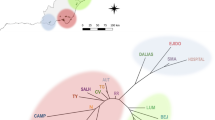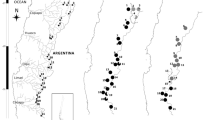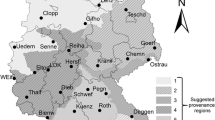Abstract
Human activities have deeply transformed the Mediterranean landscape for millennia. Wetland and riverbed vegetation are among the most affected ecosystems because of the value of these areas for agriculture, due to their rich soil and water availability. This has caused the fragmentation, population reduction, and extinction of many species. We focus our study on Ulmus laevis Pallas, an endangered tree species in the Iberian Peninsula, as an extreme example of these formations. We study the diversity and fine-scale spatial genetic structure of two human disturbed wetland populations with chloroplast markers and nuclear microsatellites. We evaluate their recovery possibilities, and how they will be affected by future aridification and water table depletion. Our results show that although these populations have suffered bottlenecks and have low genetic diversity, they maintain the same diversity levels as the European populations. Despite the low genetic variation that could contribute to inbreeding problems in the future, we discuss that the main threat of the species is habitat destruction. Finally, we propose some management and conservation policies to ameliorate these effects.




Similar content being viewed by others
References
Álvarez-Cobelas M, Cirujano S, Sánchez-Carrillo S (2001) Hydrological and botanical man-made changes in the Spanish wetland of Las Tablas de Daimiel. Biol Conserv 97:89–98
Antrop M (2005) Why landscapes of the past are important for the future. Lands Urban Plan 70:21–34
Casado S, Montes C (1995) Guía de los lagos y humedales de España. Ed. J.M. Reyero, Madrid
Collada C, Fuentes-Utrilla P, Gil L, Cervera MT (2004) Characterization of microsatellite loci in Ulmus minor Miller and cross-amplification in U. glabra Hudson and U. laevis Pall. Mol Ecol Notes 4(4):731–732
Collin E (2003) EUFORGEN Technical guidelines for genetic conservation and use for European white elm (Ulmus laevis). Forestry. International Plant Genetic Resources Institute, Rome
Collin E, Rusanen M, Ackzell L et al (2004) Methods and progress in the conservation of elm genetic resources in Europe. Invest Agrar: Sist Recur For 13(1):261–272
Colmenares D (1640) Historia de la insigne ciudad de Segovia y compendio de las historias de Castilla. Segovia, Madrid
Cornuet JM, Luikart G (1996) Description and power analysis of two tests for detecting recent population bottlenecks from allele frequency data. Genetics 144:2001–2014
De Luis M, Brunetti M, Gonzalez-Hidalgo J, Longares LA, Martin-Vide J (2010) Changes in seasonal precipitation in the Iberian Peninsula during 1946–2005. Glob Planet Change 74:27–33
Deiller AF, Walter JMN, Trémolières M (2003) Regeneration strategies in a temperate hardwood floodplain forest of the Upper Rhine: sexual versus vegetative reproduction of woody species. For Ecol Manag 180:215–225
Di Rienzo A, Peterson AC, Garza JC, Valdes AM, Slatkin M, Freimer MB (1994) Mutational processes of simple-sequence repeat loci in human populations. Proc Natl Acad Sci USA 91:3166–3170
Ellstrand NC, Elam DR (1993) Population genetic consequences of small population size: implications for plant conservation. Annu Rev Ecol Evol Syst 24:217–242
Fuentes-Utrilla P (2008) Estudio de la variabilidad genética del género Ulmus L. en España mediante marcadores moleculares. Dissertation, Universidad Politécnica de Madrid
Gallego-Fernández JB, García-Mora MR, García-Novo F (1999) Small wetlands lost: a biological conservation hazard in Mediterranean landscapes. Environ Conserv 26(3):190–199
Garza JC, Williamson EG (2001) Detection of reduction in population size using data from microsatellite loci. Mol Ecol 10(2):305–318
Gil L, García-Nieto ME (1990) Paleobotánica e historia de los olmos de la Península Ibérica. In: Gil L (ed) Los olmos y la grafiosis en España. ICONA, Madrid, pp 29–65
Girod C, Vitalis R, Leblois R, Fréville H (2011) Inferring population decline and expansion from microsatellite data: a simulation-based evaluation of the Msvar method. Genetics 188:165–179
Goodall-Copestake WP, Hollingsworth ML, Hollingsworth PM, Jenkins GI, Collin E (2005) Molecular markers and ex situ conservation of the European elms (Ulmus spp.). Biol Conserv 122(4):537–546
Goudet J (2001) FSTAT, a program to estimate and test gene diversities and fixation indices (version 2.9.3). Updated from: goudet J (1995) FSTAT (vers. 1.2): a computer program to calculate F-statistics. J Hered 86:485–486
Hardy OJ, Vekemans X (2002) SPAGeDi: a versatile computer program to analyse spatial genetic structure at the individual or population levels. Mol Ecol Notes 2:618–620
Hooke JM (2006) Human impacts on fluvial systems in the Mediterranean region. Geomorphology 79:311–355
Iriarte MJ (2009) Vegetation landscape and the anthropization of the environment in the central sector of the Northern Iberian Peninsula: current status. Quat Int 200(1–2):66–76
Kikuchi S, Suzuki W, Sashimura N (2011) Gene flow in an endangered willow Salix hukaoana (Salicaceae) in natural and fragmented riparian landscapes. Conserv Genet 12(1):79–89
Loiselle BA, Sork VL, Nason J, Graham C (1995) Spatial genetic structure of a tropical understorey shrub, Psychotria officinalis (Rubiaceae). Am J Bot 82:1420–1425
López RA (2000) Paleobotánica de los olmos. In: Gil L, Solla A, Iglesias S (eds) Los olmos ibéricos. Conservación y mejora frente a la grafiosis. Organismo Autónomo Parques Nacionales, Madrid, pp 49–68
López de Heredia U, Venturas M, López RA, Gil L (2010) High biogeographical and evolutionary value of Canary Island pine populations out of the elevational pine belt: the case of a relict coastal population. J Biogeogr 37:2371–2383
Luikart G, Allendorf FW, Cornuet JM, Sherwin WB (1998) Distortion of allele frequency distributions provides a test for recent population bottlenecks. J Hered 89(3):238–247
Milleron M, López de Heredia U, Lorenzo Z et al (2012) Effect of canopy closure on pollen dispersal in a wind-pollinated species (Fagus sylvatica L.). Plant Ecol. doi:10.1007/s11258-012-0125-2
Mittempergher L, Porta N (1991) Hybridization studies in the Eurasian species of elm (Ulmus spp.). Silvae Genet 40(5/6):237–243
Moreno JM (2005) Evaluación preliminar de los impactos en España por efecto del cambio climático. Ministerio de Medio Ambiente, Madrid
Moritz C (2002) Strategies to protect biological diversity and the evolutionary processes that sustain it. Syst Biol 51:238–254
Mutke S, Gordo J, Gil L (2005) Variability of Mediterranean stone pine cone production: yield loss as response to climate change. Agric For Meteorol 132:263–272
Nei M (1987) Molecular evolutionary genetics. Columbia University Press, New York
Newton AC, Allnutt TR, Gillies ACM, Lowe AJ, Ennos RA (1999) Molecular phylogeography, intraspecific variation and the conservation of tree species. Trends Ecol Evol 14:140–145
Nielsen LR, Kjær ED (2010) Fine-scale gene flow and genetic structure in a relic Ulmus laevis population at its northern range. Tree Genet Genomes 6(5):643–649
Pimm SL, Gittleman JL, McCracken GF (1998) Plausible alternatives to bottlenecks to explain reduced genetic diversity. Trends Ecol Evol 4(6):176–178
Plummer M, Best N, Cowles K, Vines K (2006) CODA: convergence diagnosis and output analysis for MCMC. R News 6:7–11
Pritchard JK, Stephens M, Donnelly P (2000) Inference of population structure using multilocus genotype data. Genetics 155:945–959
Rodríguez JA, Weatherhead EK, Knox JW, Camacho E (2007) Climate change impacts on irrigation water requirements in the Guadalquivir river basin in Spain. Reg Environ Chang 7:149–159
Stafford PJ (1995) The Northwest European Pollen Flora. Ulmaceae. Rev Palaeobot Palyno 88:25–46
Storz JF, Beaumont MA (2002) Testing for genetic evidence of population expansion and contraction: an empirical analysis of microsatellite DNA variation using a hierarchical Bayesian model. Evolution 56:154–166
Tallmon DA, Koyuk A, Luikart G, Beaumont MA (2008) ONeSAMP: a program to estimate effective population size using approximate Bayesian computation. Mol Ecol Resour 8(2):299–301
Thuiller W, Lavorel S, Araújo MB, Sykes MT, Prentice IC (2005) Climate change threats to plant diversity in Europe. Proc Natl Acad Sci USA 102(23):8245–8250
Valbuena-Carabaña M, López de Heredia U, Fuentes-Utrilla P, González-Doncel I, Gil L (2010) Historical and recent changes in the Spanish forests: a socio-economic process. Rev Palaeobot Palynol 162(3):492–506
Vekemans X, Hardy OJ (2004) New insights from fine-scale spatial genetic structure analyses in plant populations. Mol Ecol 13:921–935
Waples RS, Do C (2008) LDNE: a program for estimating effective population size from data on linkage disequilibrium. Mol Ecol Resour 8(4):753–756
Wei X, Jiang M (2012) Limited genetic impacts of habitat fragmentation in an “old rare” relict tree, Euptelea pleiospermum (Eupteleaceae). Plant Ecol 213:909–917
Whiteley RE (2004) Quantitative and molecular genetic variation in Ulmus laevis Pall. Dissertation, Swedish University of Agricultural Sciences
Whiteley RE, Black-Samuelsson S, Clapham D (2003) Development of microsatellite markers for the European white elm (Ulmus laevis Pall.) and cross-species amplification within the genus Ulmus. Mol Ecol Notes 3:598–600
Williamson-Natesan EG (2005) Comparison of methods for detecting bottlenecks from microsatellite loci. Conserv Genet 6:551–562
Zalapa JE, Brunet J, Guries RP (2008) Isolation and characterization of microsatellite markers for red elm (Ulmus rubra Muhl.) and cross-species amplification with Siberian elm (Ulmus pumila L.). Mol Ecol Resour 8(1):109–112
Acknowledgments
We would like to thank César Cardo, Alberto Pérez, and Julio Orellana for having shown us Valdelatas elm grove. We thank Segovia XXI for having allowed us collect samples in Quitapesares and helping us preserve this population. We thank Eudaldo González for the elm surveys, he has carried out all over Spain. We are also grateful to Salustiano Iglesias, Pablo Sanjuanbenito, and Cuenca Alta del Manzanares park managers for their support. We also show gratitude to Zaida Lorenzo, Elena Zafra, Eva Miranda, Jorge Domínguez, David Macaya, Gerrie Seket, Guillermo González, Miriam Fajardo, and Ana Moreno for their technical assistance and help. This study was financed by the Comunidad de Madrid (Project S2009AMB-1668). M.V. is sponsored by a PIF Grant from the Technical University of Madrid.
Author information
Authors and Affiliations
Corresponding author
Additional information
Carmen Collada and Luis Gil contributed equally to this study.
Electronic supplementary material
Below is the link to the electronic supplementary material.
11258_2013_170_MOESM1_ESM.pdf
Online Resource 1 Tables with the details of Spanish Ulmus laevis Pall. populations and the location of U. laevis trees within towns. Supplementary material 1 (PDF 48 kb)
11258_2013_170_MOESM2_ESM.pdf
Online Resource 2 Breast height diametric distribution of Quitapesares and Valdelatas Ulmus laevis populations. Supplementary material 2 (PDF 48 kb)
Rights and permissions
About this article
Cite this article
Venturas, M., Fuentes-Utrilla, P., Ennos, R. et al. Human-induced changes on fine-scale genetic structure in Ulmus laevis Pallas wetland forests at its SW distribution limit. Plant Ecol 214, 317–327 (2013). https://doi.org/10.1007/s11258-013-0170-5
Received:
Accepted:
Published:
Issue Date:
DOI: https://doi.org/10.1007/s11258-013-0170-5




